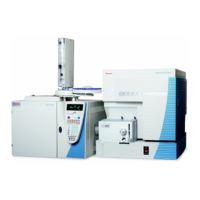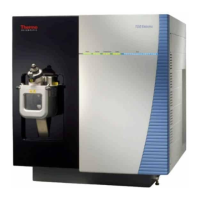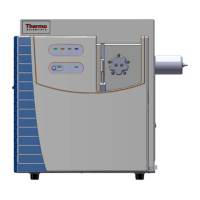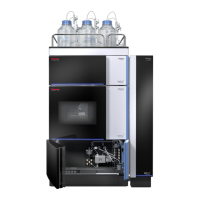2
Functional Description
Mass Spectrometer
Thermo Scientific TSQ Series Hardware Manual 23
Figure 14. Cross-sectional view of the ion source interface, Q00 ion optics, and Q0 ion optics of the TSQ Quantum Access,
TSQ Quantum Access MAX, or TSQ Quantum Ultra mass spectrometer
The ion transfer tube assists in desolvating ions that are produced by the API probe. The tube
is an elongated, 4 in. (on the TSQ Quantum Access, TSQ Quantum Access MAX, and
TSQ Quantum Ultra mass spectrometers) or 2.3 in. (on the TSQ Vantage mass spectrometer)
cylindrical metal tube. See Figure 15. Two heater cartridges are embedded in the heater block.
The heater block surrounds the ion transfer tube and heats it to temperatures up to 400 °C. A
platinum probe sensor measures the temperature of the heater block. Typical temperatures of
the ion transfer tube are 270 °C for ESI and 250 °C for APCI, but these temperatures vary
with flow rate and mobile phase composition. A decreasing pressure gradient draws ions into
the ion transfer tube in the atmospheric pressure region and transports them to the ion
transfer tube-skimmer region of the vacuum manifold. A potential of typically ±35 V (positive
for positive ions and negative for negative ions) assists in repelling ions from the ion transfer
tube to the skimmer. The vent prevent ball falls into the space occupied by the ion transfer
tube when the tube is removed, thus preventing air from entering the vacuum manifold. The
vent prevent ball allows you to remove the ion transfer tube for cleaning without venting the
system.
Front
Heater block
Ion transfer tube
Vent prevent ball
Ion sweep cone
Tube lens
Skimmer
Lens L0
Q0 quadrupole
Q00 rf lens

